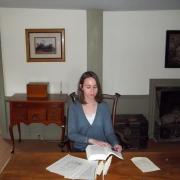History
Lodge : an indoorsy tour of America's national parks
Max Humphrey
917.352 /Humphrey
Travel, Nature, History
Max Humphrey shines a light on 10 rustic National Park lodges in all their airy, timeworn splendor. No historic photos here; the images of the architecture and interiors are as they look today, highlighting these storied places in a fresh, alluring way. Sure, the lobbies are the main stage, but Humphrey touches on grand dining rooms, guest rooms, and rustic canteens alike. He writes about the buildings themselves in terms of the historical goings-on at the time, why they were built, and the players involved, highlighting notable architectural moments and period-specific furnishings. A smattering of pop culture history adds extra bursts of levity throughout.
The great air race : glory, tragedy, and the dawn of American aviation
John (Journalist) Lancaster
629.1309 /Lancaster
History, Technology
Lancaster recounts the incredible, untold story of the transcontinental air race of October 1919. The contest awakened Americans to the practical possibilities of flight-- and riveted the nation. Most of the pilots were veterans of World War I, flying DH-4s and Fokkers that were almost comically ill-suited for long distance travel. The aviators braved blizzards and mechanical failure, landing in cornfields or at the edges of cliffs. The race was a test of endurance that many pilots didn't finish because of exhaustion, mechanical failure-- or their deaths. -- adapted from jacket
A lot of was riding on this first of its kind coast-to-coast airplane race. Billy Mitchell was hoping to have Congress create an independent air force. The post office wanted to establish an airmail service. Multiple entrepreneurs wanted the public to buy into the idea of air travel. The great transcontinental air race of October 1919 was going to prove these things were needed and practical. Lancaster provides a detailed portrait on the state of aeronautics after World War I, the characters and personalities involved in the race, and the repercussions of a successful, yet deadly contest. Air historians or people who love micro-histories will enjoy this book. -Anne M
The Monkey Trial : John Scopes and the battle over teaching evolution
Anita Sanchez
CATALOGING /
Kids, Science, History
"Arrested? For teaching? John Scopes's crime riveted the world, and crowds flocked to the trial of the man who dared to tell students about a forbidden topic--evolution. The year was 1925, and discussing Darwin's theory of evolution was illegal in Tennessee classrooms. Lawyers wanted to challenge the law, and businessmen smelled opportunity. But no one imagined the firestorm the Scopes Trial would ignite--or the media circus that would follow. As reporters, souvenir-hawking vendors, angry protestors, and even real monkeys mobbed the courthouse, a breathless public followed the action live on national radio broadcasts. All were fascinated by the bitter duel between science and religion, an argument that boiled down to the question of who controls what students can learn--an issue that resonates to this day."--Page [2] of cover.
Who controls what students can learn - parents or the government? What takes precendence, science or religion? What happens when scientific evidence is turned into a political battle? Find out in this book for young readers about - you guessed it! - the 1925 trial of science teacher John Scopes, who defied the law by teaching about Darwin's theory of evolution in the classroom. Whether the cyclical nature of these struggles provides a comfort or makes you feel hopeless, there's no doubt that history repeats itself. Find out what lessons the "Monkey Trial" holds for us today in this new book aimed at 8-12-year-olds. -Anne W
The tree and the river
Aaron Becker
jE Becker
Picture Books, Nature, History
"In an alternate past--or possible future--a mighty tree stands on the banks of a winding river, bearing silent witness to the flow of time and change..."--
Aaron Becker is back with another fabulous wordless title--don't miss it! -Casey
Empress of the Nile : the daredevil archaeologist who saved Egypt's ancient temples from destruction
Lynne Olson
932 /Olson
Nonfiction, History
"In the 1960s, the world's attention was focused on a nail-biting race against time--an international campaign to save over a dozen ancient Egyptian temples, built during the height of the pharaohs' rule, from drowning in the floodwaters of the gigantic new Aswan High Dam. But the massive press coverage of this unprecedented rescue effort completely overlooked the feisty French archaeologist who made it all happen. Without the intervention of Christiane Desroches-Noblecourt, the temples--including the Met Museum's Temple of Dendur--would now be at the bottom of a gigantic reservoir. It was a project of unimaginable size and complexity that required the fragile sandstone temples to be dismantled, stone by stone, and rebuilt on higher ground. A willful, real-life version of Indiana Jones, Desroches-Noblecourt refused to be cowed by anyone or anything. As a brave member of the French Resistance in WWII she had survived imprisonment by the Nazis; in her fight to save the temples she had to face down two of the most daunting leaders of the postwar world, Egyptian President Abdel Nasser and French President Charles de Gaulle. As she told one reporter, "You don't get anywhere without a fight, you know." Yet Desroches-Noblecourt was not the only woman who played a crucial role in the endeavor. The other one was Jacqueline Kennedy, America's new First Lady, who persuaded her husband to call on Congress to help fund the rescue effort. After a century and a half of Western plunder of Egypt's ancient monuments, Desroches-Noblecourt had done the opposite. She had helped preserve a crucial part of its cultural heritage and, just as important, made sure it remained in its homeland"--
An energetic and astute account of someone I'd never heard of before, but who exhibits all the intellect, daring, humanism, and bravery of the heroic Indiana Jones! No doubt, part of the appeal of this story is seeing a woman blaze her path in a man's world, while also leaving that world better than she found it. But there's also the historical intrigue of exploration and discovery, of war-time cunning, of the changing worlds of academia and societal norms. I'll be first in line to admit that it takes a romantic gaze to look back with enjoyment on this time period and it's colonial trappings, but the author is careful to work in acknowledgment alongside a healthy dose of the understandings of historical cultural relativism. Christaine Desroches-Noblecourt's story deserves to be told, and this book does it well. If you like this, you might be interested in reading the very excellent "The Riddle of the Labyrinth" by Margalit Fox, which recounts Alice Kober's work in deciphering the Linear B script that was used in Mycenaean civilization. -Candice
Sinkable : obsession, the deep sea, and the shipwreck of the Titanic
Daniel (Daniel Evan) Stone
910.452 /Stone
History
April, 1912. The Titanic has scarcely disappeared before plans to find and raise her began. Yet seven decades passed before it was found. Why? And of some three million shipwrecks that litter the ocean floor, why is the world still so fascinated with this one? Stone spins a fascinating tale of history, science, and obsession, uncovering the untold story of the Titanic not as a ship but as a shipwreck. He takes readers through the two miles of ocean water in which the Titanic sank, showing how the ship broke apart and why, and delves into the odd history of our understanding of such depths. He interviews scientists to understand the decades of rust and decomposition that are slowly but surely consuming the ship. And Stone turns inward, looking at his own dark obsession with both the Titanic and shipwrecks in general. - adapted from publisher info
This is an interesting book for any person who had an obsession with the Titanic in the 4th grade. This gives a broader range of the Titanic tragedy and the various efforts to find it in the decades since. You'll meet some new Titanic-adjacent characters! -Amanda
An assassin in utopia : the true story of a nineteenth-century sex cult and a president's murder
Susan Wels
364.1523/Wels
Nonfiction, History
From 1848 to 1881, a small utopian colony in upstate New York, the Oneida Community, was known for its shocking sexual practices, from open marriage and free love to the sexual training of young boys by older women. And in 1881, a one-time member of the Oneida Community, Charles Julius Guiteau, assassinated President James Garfield in a brutal crime that shook America to its core. This is the first book to weave together these explosive stories in a tale of utopian experiments, political machinations, and murder.
I was excited enough about this book that I went and bought a copy before the library got it...I'm hopeful it won't disappoint! For those of you who read Candice Millard's fantastic book about the assassination of President Garfied--"Destiny of the Republic"--and wondered what the heck his assassin had been getting up to before the event, this book might fill in some of those details for you. Turns out he spent a bit of time in the Oneida community in upstate New York, and if you think that it was all about making silverware, think again! There were a lot of interesting communities around this time, working to turn their ideal ways of life into a reality, and Oneida was one of the most successful. If you're a history buff with a penchant for a little of the weird, this book might be worthwhile. -Candice
American midnight : the Great War, a violent peace, and democracy's forgotten crisis
Adam Hochschild
973.91 /Hochschild
History
"A character-driven look at a pivotal period in American history, 1917-1920: the tumultuous home front during WWI and its aftermath, when violence broke out across the country thanks to the first Red Scare, labor strife, and immigration battles"--
President Woodrow Wilson, in his speech asking Congress to enter World War I, stated that we would make the world "safe for democracy." In "American Midnight," Adam Hochschild compellingly argues that at this time, democracy was in peril on the home front. From tramping down labor unions to jailing political opponents to silencing dissenting arguments (including removing public library books) to inflicting catastrophic violence against immigrants and Black Americans, America in the years of 1917-1920 was in a crisis. Hochschild explores the issues and themes that led America to the brink. He also dives in to the people who engaged and argued in the public sphere about their vision for America as well as those that were greatly impacted by this societal shift. It is a great read! -Anne M
The untold story of Larry Itliong : labor rights hero
Cristina Oxtra
j331.88 Itliong
Biographies, History
"You may have read about Cesar Chavez's leadership in organizing the well-known Delano Grape Strike and Boycott of the 1960s. But did you know it began as a strike led by Larry Itliong? He was a Filipino labor organizer who had also been working with grape pickers in California at the time. With key biographical information and related historical events, this Capstone Captivate book will uncover Itliong's story and show how it connects to Chavez's story"--
Take this opportunity to learn about an unsung hero of history and glean more information about where your food comes from! -Anne W
Sacred Britannia : the gods and rituals of Roman Britain
Miranda J. (Miranda Jane) Aldhouse-Green
200.9361 /Aldhouse-Green
Nonfiction, History, Religion, Political
Two thousand years ago, the Romans sought to absorb into their empire what they regarded as a remote, almost mythical island on the very edge of the known world - Britain. The expeditions of Julius Caesar and the invasion of AD 43 brought fundamental and lasting changes to the island. Not least among these was a pantheon of new Classical deities and religious systems, along with a clutch of exotic eastern cults including Christianity. But what of Britannia and her own home-grown deities? What cults and cosmologies did the Romans encounter and how did they in turn react to them? Under Roman rule, the old gods were challenged, adopted, adapted, absorbed and re-configured. In this fresh and innovative new account, Miranda Aldhouse-Green balances literary, archaeological and iconographic evidence (and scrutinizes their shortcomings and how we interpret them) to illuminate the complexity of religion and belief in Roman Britain, and the two-way traffic of cultural exchange and interplay between imported and indigenous cults. Despite the remoteness of this period, on the threshold between prehistory and history, many of the forces, tensions, ideologies and issues of identity at work are still relevant today.
This book is literally as the blurb says--it describes the religious atmosphere of Britain when the Romans blasted onto the scene, and uses various historical accounts and archaeological finds to give evidence. If that's your thing, then you'll love it! It can lean a little to the technical side, and assumes the reader might have a slight comfort level reading socio-archaeological articles, but the information is presented in nice, small bites so you don't get lost in the details. If deep British history is your cup of tea, and you don't need a lot of color photos to spice up the info, then you won't be disappointed. -Candice






I have caught the travel-planning bug and am fantasizing about all the places to go. Surely I'm not the only one who dreams of staying in cozy lodging in one of our nation's majestic national parks? If you're like me in that sense, do take a look at this book. "Lodge" had me at plaid, the buffalo pattern unmistakingly a siren call to join the great outdoors. Really that's all I want in a vacation: the woods, the sweat, and the constant tiny insect bites reminding me I'm alive. (Just kidding. I slather myself in DEET the second I see my first mosquito. Just say No to itchy skin, kids!) -Melody